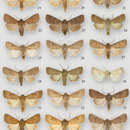Description
provided by Zookeys
Protorthodes melanopis is most easily recognized by the pale gray-brown forewing ground color, which emphasizes the contrast between the reniform spot, orbicular spot, and the ground color. The pale hindwings of the males contrast with the forewings. Forewing length varies from 11 to 14 mm. In males the hindwing is white and translucent, with some fuscous shading on the veins and wing margin; in females the hindwing is covered with a fuscous sheen, darker on the veins and wing margin. The antennal pectinations and wing size are the same as in Protorthodes oviduca. Structurally, the species differs from Protorthodes oviduca by the vesica character given in the key. The coil in the vesica in Protorthodes melanopis is mesial rather than basal, and the dorsal lobe on the sacculus tapers to a pointed process, whereas the dorsal lobe of the sacculus is rounded in Protorthodes oviduca and Protorthodes orobia.
- license
- cc-by-3.0
- copyright
- J. Donald Lafontaine, J. Bruce Walsh, Clifford D. Ferris
- bibliographic citation
- Lafontaine J, Walsh J, Ferris C (2014) A revision of the genus Protorthodes McDunnough with descriptions of a new genus and four new species (Lepidoptera, Noctuidae, Noctuinae, Eriopygini) ZooKeys 421: 139–179
- author
- J. Donald Lafontaine
- author
- J. Bruce Walsh
- author
- Clifford D. Ferris
Distribution
provided by Zookeys
Eriopyga melanopis: syntypes 4 ♂, 1 ♀, BMNH, examined. Type locality: Arizona, Maricopa Co., Phoenix.
- license
- cc-by-3.0
- copyright
- J. Donald Lafontaine, J. Bruce Walsh, Clifford D. Ferris
- bibliographic citation
- Lafontaine J, Walsh J, Ferris C (2014) A revision of the genus Protorthodes McDunnough with descriptions of a new genus and four new species (Lepidoptera, Noctuidae, Noctuinae, Eriopygini) ZooKeys 421: 139–179
- author
- J. Donald Lafontaine
- author
- J. Bruce Walsh
- author
- Clifford D. Ferris

